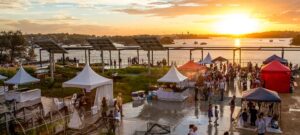
Historic Coal Loader site offers perfect green roof platform for Nara Native Zoysia
By Sandra Godwin
Each week thousands of people visit the Coal Loader at Balls Head, Waverton in New South Wales, to enjoy the fresh air and million-dollar views across Sydney Harbour. It’s a far cry from the days when workers laboured under a thick layer of black dust to unload coal from bulk carriers and transfer it onto smaller, coal-fired steam ships. At the heart of the Coal Loader site is a substantial area of Nara Native Zoysia turf. We look into the site’s history and how Nara Native has become a feature piece for all to enjoy.
The Coal Loader at Balls Head, Waverton, operated for more than 70 years until it was decommissioned in 1992. Five years later it was dedicated as public open space and since then, North Sydney Council has transformed what was an unsightly relic of heavy industry, into the picturesque Coal Loader Centre for Sustainability.
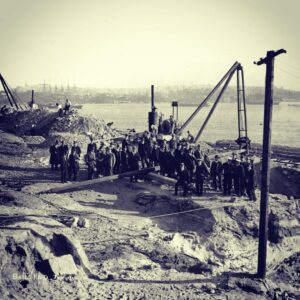
Officially opened in March 2018, the revamped platform at the Coal Loader is now one of the largest, publicly accessible, green rooftops in Australia. At its heart is a substantial area of Nara Native Zoysia turf.
Landscape architect David Banbury designed the site with a number of aims in mind, one being to demonstrate a range of suitable native plants for Sydneysiders to use in rooftop gardens.
The turf and other plants across the different zones were chosen for their ability to cope with wind, full sun and shallow, imported soil.
“There were a few parameters we looked at for the turf,” David said. “I wanted something native that was going to be low maintenance. We didn’t want a bowling green as such because the whole Coal Loader site has a sustainability focus. So, it’s about reducing the resources needed to maintain it. We wanted something that was reasonably drought tolerant, could take a reasonable amount of wear, that we didn’t have to mow every two weeks.”
First, they conducted a six-month trial, across two seasons of two turf varieties: Nara Native Zoysia and a soft leaf Buffalo.
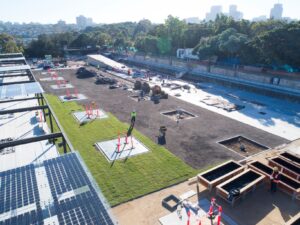
The small-scale trial matched the profile proposed for the platform, with 200mm of an engineered soil medium designed by a former CSIRO scientist, and subsurface drip irrigation. “Nara Native Zoysia performed very well during the trial period and it developed a dense tuft of a few centimetres in height,” David said. “It also produced a nice little seed head. In the end, the Buffalo got a caterpillar attack that let weeds into it. We didn’t mow either of them, and after six months, the Zoysia was much more weed free. Based on the results of that trial, that’s why we decided to go ahead with it.”
The large area of lawn is at the centre of the platform and has proven popular for picnicking and events, such as concerts, fashion shows, yoga classes and outdoor theatre.
The sub-soil drainage system allows the lawn to dry quickly after rain. Stormwater is stored in tanks located in one of four 180m-long tunnels under the platform, and then recirculated to irrigate all the gardens and lawn areas.
David said the turf was still recovering from damage caused by blockages in the drip irrigation last year, which meant it dried out during the hot drought period. A spring program of top-dressing with fertiliser, and the installation of supplementary overhead irrigation as a backup, are planned to help bring the grass back to its best condition.
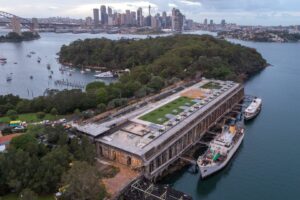
“With the COVID situation we’re getting a lot more people outdoors throughout the winter and summer,” he said. “That’s also putting extra pressure on all of our parks.”
People counters at the main entrances show the platform has up to 1000 visitors a day during the week, 2500 on weekends, and as many as 5000 attending major events such as the artisan markets.
“People have taken to the space with great enthusiasm,” David said. “It’s one of the best harbour- viewing spots you can get – a big, flat, open area, right on the harbour with panoramic views and beautiful sunsets.”
The sustainability focus extends to the other plantings which include dwarf species of fruit trees suitable for urban garden planters, and areas where individuals and groups can grow their own fruit, vegetables and flowers.
The site also houses a native bush nursery that grows species from seed collected around the local catchment by Council staff and volunteers. Seedlings from the nursery were used to plant out a buffer zone alongside the platform, to minimise the risk of exotic plants escaping from the gardens and spreading into the bushland on Balls Head Reserve.
The dramatic metamorphosis of the Coal Loader from an ugly vacant industrial site into a welcoming attractive public space, has been acknowledged with numerous awards.
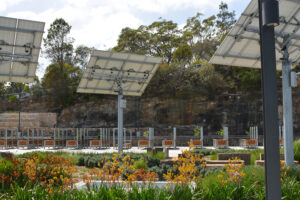
They include:
- The Parks and Leisure Australia’s 2018 Park of the Year (NSW and National) and Community Facility of the Year (NSW).
- The Australian Institute of Landscape Architects Cultural Heritage Award of Excellence 2018.
- The 2018 GOV Design Award for Urban Design.
- The 2019 Australian Institute of Landscape Architects National Landscape Architecture Award for Land Management (for the Waverton Peninsula Strategic Master Plan, which includes the Coal Loader site).
- The 2019 NSW Local Government Culture Change Innovation and Excellence Award.

In June, the NSW Government listed the Coal Loader complex on the State Heritage Register in recognition of its indigenous history (it is located on the traditional lands of the Cammeraygal people), as well as the significant role it played in the industrial history of Sydney Harbour.
The heritage listing covers the original coal loading platform, machinery and workshop buildings, as well as a celebrated indigenous rock engraving of a whale that was unearthed in 2008.
David welcomed the heritage listing and its recognition of the “layers of history” attached to the site.
“The Coal Loader for many years has been recognised as having state heritage significance but it had never gone through the formal process of listing,” he said. “State listing gives it that extra level of protection. It also opens up some avenues of heritage grants only available to state-listed level projects.”
The real winners though, are the people of North Sydney who fought against early proposals to sell the disused site for residential development.
“There was a groundswell of community opposition to that,” David said. “Eventually, then-Premier Bob Carr announced the Coal Loader, the old BP site on the other side of the peninsula, and a number of other sites around the Harbour would be preserved.”
